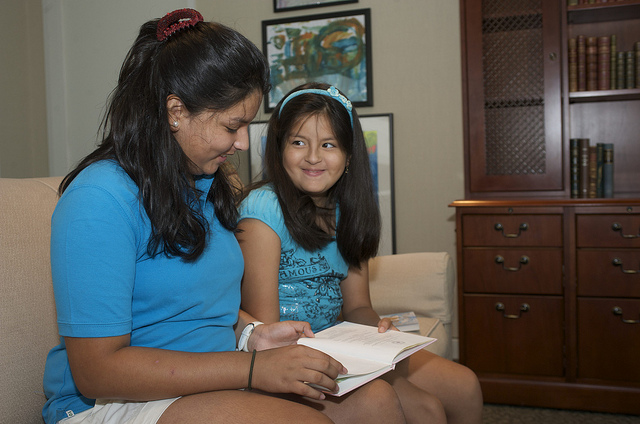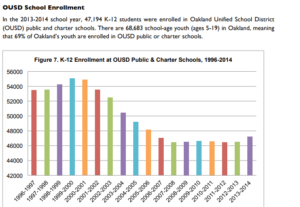OUSD’s predicament of being a declining enrollment district while charter schools grow is not unique, and it needn’t be so painful according to a new report out of the Center for Reinventing Public Education. The report had some hard truths on both “sides.” And some key lessons for each public school sector to accept if we are to really serve the public.
Better Together Ensuring Quality District Schools in Times of Charter Growth and Declining Enrollment, isn’t about Oakland, but it could be. The authors trace 7 large districts’ experiences managing their schools and central office, under charter school growth and declining enrollment. That is one of Oakland Unified’s struggles right now. There are some nuggets here to learn from and I hope our decision makers are listening.
Declining enrollment is a trend in most big cities, charters or not.
The earliest stat I could find on Oakland enrollment on CDE was 1993. Prior to any charters, the district then had 51,748 students. You can see the chart from OFCY that shows combined charter and district enrollment. Even when you add the number of charter and district students, enrollment is declining from historic rates, here’s the data from OFCY. We are at roughly 48,000 students in the combined sectors now.
This declining overall enrollment is a stable trend in large cities dating back to the 70’s.
Another key point was that districts really are built to grow and not to shrink, and they struggle may struggle to maintain quality with decreases in enrollment. These trends predate charter schools, so even in the absence of charters, districts would be facing similar challenges.
And how they respond matters, “while districts can respond to enrollment loss in sustainable ways, shortsighted ‘fixes’ can hurt students” the authors state, demonstrating the downward spiral of ill designed cuts. They note that some districts increased class sizes, while others reduced them, during declining enrollment. So how districts react matters.
Which brings me to a second point they made, which initially bothered me, but sunk in; “declining enrollments may not be charters’ fault, but it is their problem.” Anyone watching recent charter applications in Oakland feels the pressure of the district’s challenges as barrier to charter approval, and trustees have said as much. And while it sounds trite, they are all our kids, when the district falters and kids are hurt, it hurts, similarly, when charters fail, it’s bad for kids.
While the nature of charter schools is that they are independent and somewhat disorganized as a sector, they need to better come together and address the sector wide challenges. And part of that means addressing the challenges of the district and overall student population as issues charter schools and the charter sector need to address. Especially as charter school numbers increase, the problems of public education and the district become charter school problems.
Themes, Challenges, and Opportunities
Charter public schools are here to stay, and individual charters need to find a better and more productive way to work together as a sector and with the district. Oakland Unified is facing a budget crisis, even with a slight bump in enrollment this year.
There are structural issues in OUSD that need to be addressed, and a structural deficit. And depending on how OUSD addresses those challenges that could put it in a downward spiral where cuts reduce school quality which reduce enrollment, engendering more cuts, and so on and so on.
But it doesn’t have to be that way. Some districts have maintained or increased quality while shrinking, again, the choices matter.
Seeing beyond a zero sum game and towards a “grand bargain”
The sectors need to come together and think harder about creating the best learning opportunities for students regardless of sector, and the charter sector has to take more responsibility for buffering the sometimes painfully disruptive aspect of education reform. This requires that we have an active dialogue, agree to principles and think more holistically about the range of students in Oakland and health of the district and public education sector. We need to develop a policy agenda around collaboration, advocacy, and more deliberate planning of charters to explicitly meet existing gaps or complement district programming.
The authors call for a “grand bargain” where charters take a more active role in supporting the overall public education sector, including taking on some of the District’s legacy costs. In the case of Oakland this would mean charters helping pay down the debt to the state, for example, which some but not all do now. And districts would agree to adjust the way they do business going forward, and also to really look at more equitable ways to share resources and the responsiveness and viability of their portfolio of schools.
Shades of Oakland
Though Oakland was not included in the report, it could have been. The stories are the same around the challenges many cities face. They differ around the answers, and some districts have managed relatively well through the difficult times of declining enrollment, others not so much.
We did start to embark on a “grand bargain” here—the equity pledge. But politics and lack of will on all sides, basically killed that, or at least left it withered to die on the vine.
So where do we go from here, we have two public education sectors, vying for the same territory with roughly the same mission, who are chaotically coexisting but not collaborating. Families deserve better, and the CRPE reports identifies a better way. I hope we can listen, though the pull of politics is often stronger than that of reason.



Privately managed charters and publicly managed charters are in a zero sum game to gain increase market share of their private opponents. That’s the charter law. Why play nice with an opponent that is out to grow by reducing your market share? They are not all our kids. The only kids public schools are primarily responsible for are public school kids. Not Catholic school kids, not Alameda County school kids located in Oakland; and not Board authorized privately managed charter school kids.